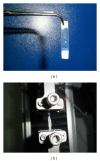Role of corneal epithelium in riboflavin/ultraviolet-A mediated corneal cross-linking treatment in rabbit eyes
- PMID: 23936826
- PMCID: PMC3712226
- DOI: 10.1155/2013/624563
Role of corneal epithelium in riboflavin/ultraviolet-A mediated corneal cross-linking treatment in rabbit eyes
Abstract
Purpose: To evaluate the role of corneal epithelium in riboflavin/ultraviolet-A (UVA) mediated corneal collagen cross-linking treatment.
Methods: Fifty New Zealand rabbits were divided into 5 groups: UVA treatment with or without corneal epithelium, UVA+riboflavin treatment with or without corneal epithelium, and control without any treatment. All rabbits were sacrificed after irradiation and subsequently 4 mm × 10 mm corneal strips were harvested for biomechanical evaluation.
Results: UVA irradiation alone did not enhance the maximal stress and Young's modulus of corneal specimens with (3.15 ± 0.56 mpa, 1.00 ± 0.09 mpa) or without (3.53 ± 0.85 mpa, 0.94 ± 0.21 mpa) the corneal epithelium, compared to specimens in the control group (4.30 ± 0.68 mpa, 1.03 ± 0.24 mpa). However, UVA irradiation combined with riboflavin significantly increased the maximal stress and Young's modulus of corneal specimens with (5.27 ± 1.09 mpa, 1.23 ± 0.23 mpa, P < 0.05) or without (7.16 ± 1.88 mpa, 1.42 ± 0.16 mpa, P < 0.05) corneal epithelium when compared to the control group. The maximal stress and Young's modulus of cornea in UVA+riboflavin and "epithelium-off" group were 35.9% and 15.4% higher compared to the UVA+riboflavin and "epithelium-on" group, respectively (P < 0.05).
Conclusions: Our study shows that UVA+riboflavin treatment significantly affects the biomechanical properties of the cornea with and without epithelial removal. However, corneas without epithelium seem to benefit more compared to corneas with the epithelium.
Figures




References
-
- Jhanji V, Sharma N, Vajpayee RB. Management of keratoconus: current scenario. British Journal of Ophthalmology. 2011;95(8):1044–1050. - PubMed
-
- Sekundo W, Stevens JD. Surgical treatment of keratoconus at the turn of the 20th century. Journal of Refractive Surgery. 2001;17(1):69–73. - PubMed
-
- Colin J, Cochener B, Savary G, Malet F. Correcting keratoconus with intracorneal rings. Journal of Cataract and Refractive Surgery. 2000;26(8):1117–1122. - PubMed
-
- Wollensak G, Spoerl E, Seiler T. Riboflavin/ultraviolet-A-induced collagen crosslinking for the treatment of keratoconus. American Journal of Ophthalmology. 2003;135(5):620–627. - PubMed
-
- Wollensak G, Spoerl E, Seiler T. Stress-strain measurements of human and porcine corneas after riboflavin-ultraviolet-A-induced cross-linking. Journal of Cataract and Refractive Surgery. 2003;29(9):1780–1785. - PubMed
Publication types
MeSH terms
Substances
LinkOut - more resources
Full Text Sources

